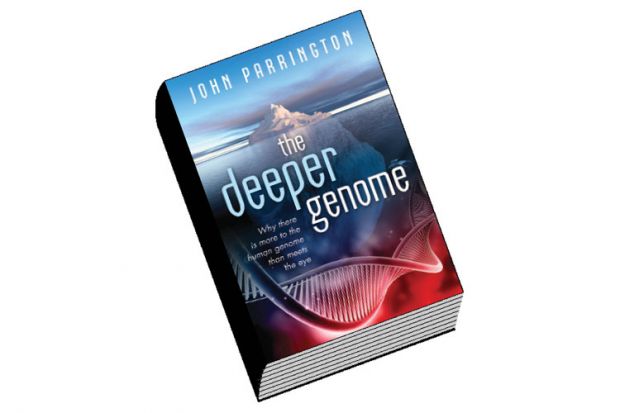In 2001, the Human Genome Project announced that among the 3 billion chemical letters of DNA, which encoded 22,000 genes, just 2 per cent of the sequence made proteins, the building blocks of life. What was the other 98 per cent doing? Some must be regulatory DNA that determines when and where during development a gene is expressed, but the consensus at the time was that most of the rest was tolerable “junk” that didn’t do any particular harm. It is here that molecular biologist John Parrington enters the discussion with The Deeper Genome. He describes the “central dogma” of how DNA makes RNA, and RNA makes proteins, and how it came to be, in clear and simple terminology. And he then proceeds to dismantle it.
The past 15 years have seen a revolution in our understanding of how the genome is organised, with a movement away from the simple view that it is linear, with one gene following the next as a functionally separate entity. Particularly important in this shift has been the ENCODE (ENCyclopedia of DNA Elements) research project, which determined how much of human DNA is functionally (biochemically) active. The answer is…wait for it…nearly all of it! This astonishing result would spawn a bitter debate among scientists about whether biochemical activity really means function. Certainly the notion that most DNA is junk now seems dead in the water; we now see extensive regulatory DNA as providing the key to how different tissues can perform all human functions with just 22,000 genes – fewer than a grape!
Parrington discusses how a gene, using its regulatory regions, can produce different sequence variants for itself at different times or in different tissues, thereby increasing its functional potential. The environment can change the gene’s expression by leaving marks on DNA that can be carried over to the next generation, in a modern version of Lamarckian inheritance. Fifty years before Darwin, Jean-Baptiste Lamarck had the brilliant idea that the environment could influence heredity, and was ridiculed ever since. Yet we now know, for example, that stress in a pregnant mouse changes the structure of a stress-responsive gene whose modified DNA is passed down to its offspring and, in turn, changes their stress-related behaviour. Who’s laughing at Lamarck now?
Other major advances include the realisation that new species of RNA lurk within the genome that can regulate the classical mRNA that is transcribed from DNA and translated into protein. These new species of RNA can be engineered to inactivate mutated disease mRNAs. “Jumping genes” – problematic when they disrupt a DNA sequence and cause disease – can change gene expression patterns even among different brain cells within an individual. Marry that to the environmental modulation of gene activity, and one can see how the environment allied with the dynamic genome can generate unique personalities even between identical twins. I know this first-hand: my partner is one half of a monozygotic sibship – clones in looks only.
As Parrington shows, the complexity of the genome is related to brain function. This has played a key role in the evolution of humans from their ape-like ancestors, partly by leading to delayed neuronal maturity that would enhance learning, memory and consciousness. This section of the book is more speculative, but he nonetheless provides compelling examples for almost every statement. The scholarship he displays in putting all these new developments together, and his narrative skill in connecting the genome and the “neurome”, are among the reasons I could not put this book down. I have placed The Deeper Genome on our first-year biology undergraduates’ reading list. It’s a game-changer and a masterpiece for anyone interested in biology. Besides, it has a cover that nicely says it all: the tip of an iceberg and all that lies beneath.
Charalambos P. Kyriacou is professor of behavioural genetics and studies biological rhythms, University of Leicester.
The Deeper Genome: Why There is More to the Human Genome than Meets the Eye
By John Parrington
Oxford University Press, 272pp, £18.99
ISBN 9780199688739
Published 28 May 2015
POSTSCRIPT:
Print headline: As the helix unwinds
Register to continue
Why register?
- Registration is free and only takes a moment
- Once registered, you can read 3 articles a month
- Sign up for our newsletter
Subscribe
Or subscribe for unlimited access to:
- Unlimited access to news, views, insights & reviews
- Digital editions
- Digital access to THE’s university and college rankings analysis
Already registered or a current subscriber? Login




